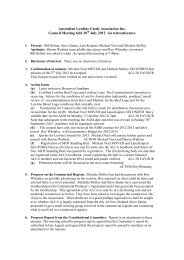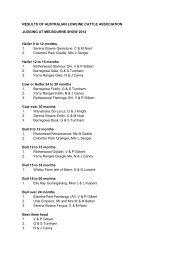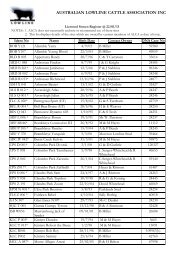Lowline Journal 2012 - Australian Lowline Cattle Association
Lowline Journal 2012 - Australian Lowline Cattle Association
Lowline Journal 2012 - Australian Lowline Cattle Association
You also want an ePaper? Increase the reach of your titles
YUMPU automatically turns print PDFs into web optimized ePapers that Google loves.
MARKET WRAPplies were also tight, with fewercattle entering feedlots in thestart of 2011 due to excessivelywet conditions.Over the autumn periodyearling steer rates averaged338c, finishing 9pc above 2010.National grown steer priceswere spurred on by the competition,averaging 333c.● Feeders: Feeder rates variedthroughout autumn and pricemovements were generallydetermined by supply ratherthan demand. Prices tended toshow little movement, andwere resilient to the demandshocks from Japan.Feedlots were keen to sourcecattle before winter. This leftmost short fed prices from194c-225c, while long fed ratesfor Angus cattle settled on 219c.WinterTHE winter months presentedthe biggest challenges to the<strong>Australian</strong> cattle market, with anumber of external demandshocks flowing through to cattleprices. Tough trading conditionsin the Indonesian andJapanese export markets creatednegative market sentiment.● Prices: Prices went againstthe established trend of early2011, and retreated throughwinter, with several externaldemand factors influencing themarket. Export processors useda lot more caution, with uncertaintyin the Japanese and USmarkets causing concern.The EYCI declined duringJune as winter represented theperiod when the young cattlemarket was at its lowest.The cautious demand fromprocessors resulted in fewernumbers being offered, withthe supply contraction offsettingthe lower demand.Despite the few setbacks theEYCI gained 9.25c for theperiod, to finish August on397.5c.This was still 34c higher thanthe same time in 2010. Theannual low point was set inJuly, as the EYCI hit 370.5c.Cow prices also increasedover winter, despite the initialweaker trends with global manufacturingbeef demand underpinningthe market.The national cow indicatoraveraged 179c during winter,2pc higher than the 2010 winteraverage.The demand for restocker cattle was strong through 2011.● Slaughter and direct-toworksrates: National cattleslaughter was 8pc lower inwinter compared with the previouscorresponding period.Producers elected to hold cattlethrough the colder monthsin response to the mixeddemand stemming from someexport markets. This in turn ledto some processors undertakingmaintenance periods, withnumbers tight due to lowerprices.The better seasonal conditionsenabled cattle to be withheld,with producers optimisticof better market conditionsduring spring. Yearling steerrates generally ranged from300c-350c during winter, andnational rates averaged 316c,similar to 2010. Heavy-grownsteer rates averaged 310c, 3pclower year-on-year.Medium-weight cow ratesaveraged 261c, 4pc above 2010winter levels.● Feeders: Feeder prices easedearly, but were forced up bythe season, restocker demand,and some producers opting tobypass feedlots and grass-finishcattle themselves. Despitethese factors, averages werehigher than 2010, and firmwith autumn.SpringRAIN in Queensland helpedkick demand.Export trading conditionsremained tough with the highA$ and the sluggish demandprevailing. However, the constrainedsupplies ensuredprices were historically strong.Restocker competition was alsostrong, with most grades ofsuitable cattle generating plentyof interest.● Prices: Despite the greateravailability of young cattle,prices during spring wererobust, with notable restockerdemand underpinning the market.The EYCI rarely dippedpast 395c. Demand was red hotat times. With rainfall almost aweekly occurrence supplieswere constrained, with producerselecting to hold cattle andsell at heavier weights.Yearling restocker steerprices averaged 10pc higher on200c, while yearling feedersteer prices improved 11pc,averaging 199c. Heavy yearlingtrade steer prices were 8pchigher than last year at 193c.Despite the A$ trading at ornear parity for much of theperiod, and the increasingglobal economic uncertainty,grown cattle categories finishedwell above the same time in2010. The Japan ox indicatoraveraged 11c higher on 193c,and medium cows were 7cdearer on 147c.● Slaughter and direct-toworksrates: Springtime slaughterlevels were only 1pc higherthan 2010 with the biggestincreases in Queensland and SAduring September.Despite wet conditions morecattle were slaughtered than in2010. Direct-to-works rates wentagainst the typical seasonaltrend and increased, with demandintensifying.In late November, processorstried to ease rates as more finishedcattle entered the physicalmarkets.<strong>Cattle</strong> were in excellent conditionand carcase weights wereabove the seasonal average.Processors were also faced witha high A$.Yearling steer rates wereexceptionally strong, averaging360c, 14pc higher than 2010.Japan ox averaged 18c deareron 336c.● Feeders: Feeders faced tightsupply for most of spring, withthe wet forcing the cancellationof consigned cattle, young cattlebeing grown out to heavierweights, and the upbeat competitionfrom restockers.Rates remained firm withoffering rates at, or near, themaximum feasible levels.Short-fed steers averagedhigher year-on-year, generallyfrom 195c-230c.Domestic fed cattle werestrongly pursued by the supermarkets,with prices from 215c-240c.<strong>2012</strong> AUSTRALIAN LOWLINE CATTLE ASSOCIATION JOURNAL 29








